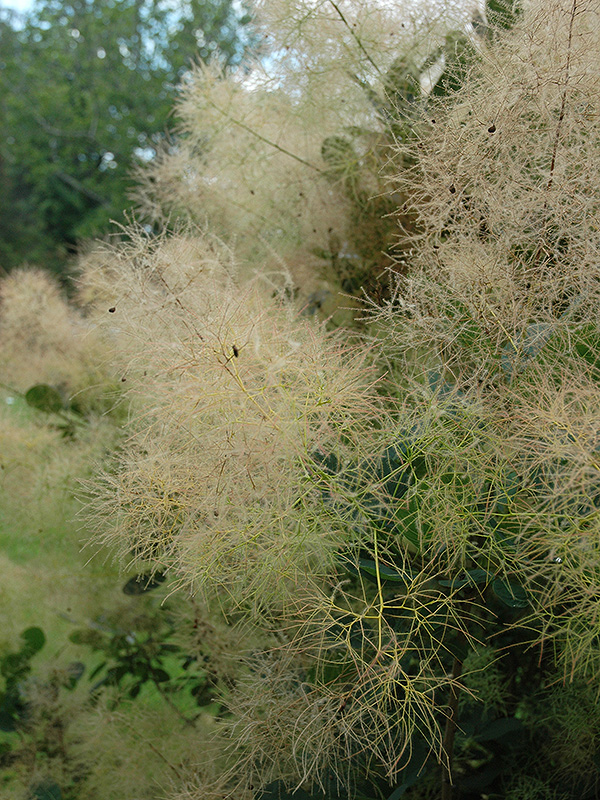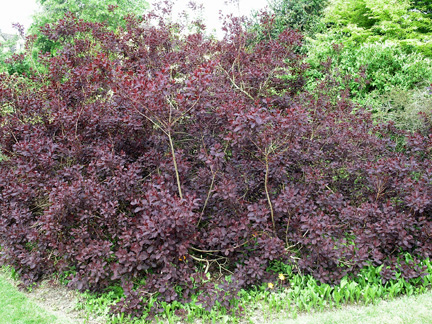
Woody > Cotinus > Cotinus coggygria > Cotinus coggygria
Cotinus coggygria
Common Smoketree, Smokebush
Origin: Europe and Asia.
Mike's
Opinion


"
An easy-to-grow tree/shrub that thrives on neglect. It is versatile in the landscape, and can be used in a border, grouping or as a specimen in a garden with its long flowering period. The long panicles produce a nice “smoke” effect when in bloom. Autumn colours are vibrant with red-orange-yellow.
Michael Pascoe, NDP., ODH., CLT., MSc. (Plant Conservation)
"
| Family |
| Anacardiaceae |
| Genus |
| Cotinus |
| Species |
| coggygria |
| Category |
| Woody |
| Type |
| Tree (deciduous) |
| Pronunciation |
| USDA Hardiness Zone |
| 4-9 |
| Canadian Hardiness Zone |
| 3-8 |
| RHS Hardiness Zone |
| H4-H7 |
| Temperature (°C) |
| -38 |
| Temperature (°F) |
| -35 |
| Height |
| 3 - 4.5 m |
| Spread |
| 3 – 3.5 m |
Photographs
Description and Growing Information
Flowering Period
| General Description |
| Can be a great accent in a shrub border. It flowers from June - September with large panicles of wispy hairs that give the effect of a cloud of smoke. Beautiful autumn colours. It is easy to grow in any soil condition other than wet. |
| Landscape |
| This plant could be used in a shrub border or in difficult sites. It can grow in many soil conditions other than moist. In gardens, it can be used as a specimen, small groupings or to get the flowering effect of mid-late summer. |
| Cultivation |
| Plant in full sun. It grows in well drained, loamy soil that is acidic or alkaline. Can be grown in less than perfect conditions as long as the soil isn’t wet. |
| Shape |
| Round, dense, symmetrical, bushy, wide spreading. |
| Growth |
| Medium |
| ID Characteristic |
| Has a pink “smoke” effect when in flower from June-September. It has a rounded shape with bluish-green leaves which turn a stunning yellow, orange and red in the autumn. Crushed leaves produce an odour of orange peel. |
| Pests |
| Verticillium wilt can sometimes be a problem when the soil is too fertile. Rusts, leaf spots, leaf rollers and San Jose scale can also occasionally attack this species. |
| Habitat |
| Found in North America, Europe and Asia. Tolerates any soil conditions as long as it’s not too wet. |
| Bark/Stem Description |
| New growth is purple-brown and smooth, covered with a waxy bloom. Older bark is light grey broken up into small, thick blocks. |
| Flower/Leaf Bud Description |
| Small, 2 mm long, dark brown with acute scales. |
| Leaf Description |
| Bluish-green, alternate, oval, 2.5 – 8.75 cm long and wide, long petiole, parallel veins from midrib. When leaves are crushed they smell like orange peel. |
| Flower Description |
| On the 15-20 cm long panicle, small yellowish 5 petaled flowers form. Later, showy smoky pink hairs develop on the pedicels and peduncle. |
| Fruit Description |
| Small, 2-3 mm oval, dry hard and brown; not very showy. |
| Colour Description |
| Blueish green leaves in summer turning a mix of yellow orange and red in the autumn. Yellowish flowers in June with pink hairs from June to September. |
| Notable Specimens |
| Vineland Research Institute, Beamsville, Ontario, Canada. Port Dover Cemetery, Port Dover, Ontario, Canada. |
| Propagation |
| Easy to transplant and establish. Can be grown from cuttings or seed. The seed will require 30-60 minutes of acid and 3 months at 5 ºC. Cuttings should be done over the winter in flats or beds and not disturbed until spring. Early June is the best time to take the cuttings. |


